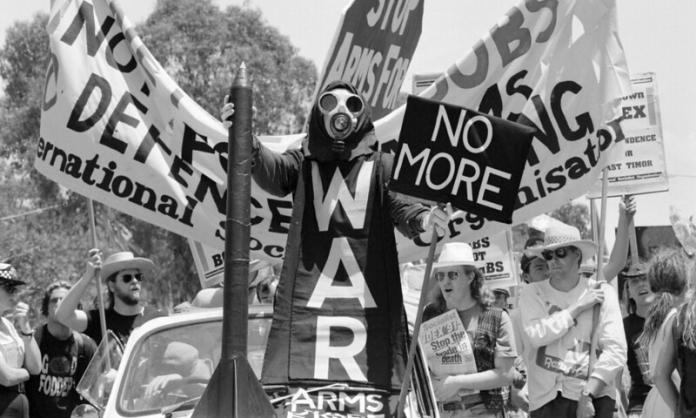The military and the monetary
Get together whenever they think it’s necessary
They turn our brothers and sisters into mercenaries
They are turning our planet into a cemetery
—Gil Scott Heron
To wage a war for empire, the political, industrial, economic and social forces in society must be combined and organised to unleash murder and destruction on a colossal scale. To stop such an obscenity is no easy thing.
We keep being told that we’re at an “inflection point” in world history. It’s true. The world’s rulers have launched an arms race to prepare for the next mass slaughter. Australia’s political class, Labor and Liberal, has joined the spree.
We’re in the midst of sickening national celebrations over the decision to invest in some of the most sophisticated machines of mass murder that the world has ever seen. At vast cost, “our” nuclear submarines will be able to project incomprehensible levels of lethal force in every ocean and to every continent on Earth, and especially to China. And there’s plenty more to come—from Tomahawk cruise missiles to autonomous killing drones to cyber warfare.
So for those of us appalled by the Australian government’s determination to fuel the spiral to war, it’s timely to look at what’s needed to win. As many of us know from experience, it takes a lot to stop a war.
The US and Australian armies left perhaps 3 million dead when they left Vietnam in 1973, overwhelmingly Vietnamese people. To kick the war machine out took a heroic decade-long struggle by a peasant army fighting for national liberation. It took a prolonged mass, radical, defiant movement in the streets of the US, Australia and other imperialist countries. It took an enormous revolt in the US armed forces, with soldiers simply refusing to fight.
I began my involvement in the peace movement as a high school student in the early 1980s. Everyone knew we stood in the shadow of the mighty movement that had helped to end the Vietnam war. My first protest was one of the colossal Palm Sunday peace marches. We were protesting against US military bases, the escalating new cold war, and Australia’s part in the nuclear arms race—in particular from the mining of uranium. Tens of thousands, sometimes hundreds of thousands of protesters flooded the streets every year.
Looking back on it many of us, myself included, were hopelessly naive. But we got at least one thing right—that protest politics can have an impact. We were part of a movement in which, at its strongest, waterfront workers banned the docking of “nuclear capable” US warships in Australian ports, metalworkers banned any work connected with building uranium mines, and a national strike was held by railway workers to back a Townsville shunter who was stood down after to refusing to work a load of uranium ore.
Labor was elected in 1983 on a platform of banning uranium mining. Once in government, the party sold out, allowing the massive Olympic Dam/Roxby Downs project—one of the world’s biggest uranium mines—to be developed on the land of the Kokatha people in South Australia. Labor never moved a muscle to ban nuclear ships or shut US bases such as Pine Gap, crucial to US surveillance and war fighting. “Yellowcake Bob” became a popular put-down of right-wing Labor Prime Minister Bob Hawke.
Despite Labor’s sell-out, the movement of that time left a legacy—most obviously on the issue of uranium mining.
Australia has nearly one-third of the world’s known uranium reserves but supplies less than 10 percent of the world market for the commodity. The development of the Jabiluka uranium mine was blocked in the 1990s by a campaign led by the Mirrar people in the Northern Territory, backed by protests on their country and in the cities. In the 2010s, determined opposition from Aboriginal people, backed by unions and an activist campaign, stopped the development of a nuclear waste dump at Muckaty station in the Northern Territory. Protests in South Australia continue, including against a plan to dump nuclear waste in the Eyre peninsula.
Protests against war and the arms race have also revived periodically, including the tradition of civil disobedience—of protesters putting our bodies on the line to disrupt the war machine. In 1991, a small group of activists toured the country to organise a week-long blockade of the AIDEX arms fair, held in Canberra at the end of that year. More than a thousand protested, hundreds were arrested, and AIDEX was never held again. Similar tactics on a smaller scale disrupted the Land Forces war industry jamboree in Brisbane in the past few years. Protests at the US military base at Pine Gap were a feature of the 1980s, and were revived as recently as 2016.
Perhaps the biggest protests in the history of Australia—and maybe the biggest in human history as they spread to 600 cities around the world—happened in 2003 when US, UK and Australian forces spearheaded the invasion of Iraq. Maybe 250,000 marched in Melbourne, and tens of thousands in other cities.
But it takes a lot to stop a war. One day of marches, even of stupendous size, was never going to be enough.
I was working in construction at this time. An onsite union meeting voted overwhelmingly to support any workers who wanted to attend a protest when the war started. Sentiment was there to be mobilised. But the decline of organised left-wing political forces, especially in the unions, limited the staying power of the protest movement in the US and Australia.
In the UK, a far left that was larger than the US or Australia was central to the Stop the War Coalition, which organised regular mass mobilisations against the UK military presence in Iraq. This at least meant that the political establishment, in particular UK Labour Prime Minister Tony Blair, paid a heavy price for its part in the destruction of Iraq and lies about weapons of mass destruction, which had justified the war.
Despite this, the US and its allies won a rapid military victory in Iraq—and the bodies piled up. Detailed estimates from Brown University in the US show 15,000 US soldiers and contractors killed in the invasion and occupation of Iraq and Afghanistan. Thirty thousand former US soldiers have killed themselves since, after being thrown on the scrapheap by the US state. Nearly 180,000 from US-allied forces, mainly Iraqi, are dead. Probably 300,000 civilians died from the violence of war, maybe several times that number from the effects of war.
No-one is really counting as the piles of corpses grow higher. Wholesale destruction of human life is of little consequence when power and profit are at stake—and the fate of an empire.
Smarting from its defeat at the hands of a peasant army, US imperialism suffered for decades from the “Vietnam syndrome”, a reluctance to deploy ground troops to impose the will of US capital and state power. Brutal US-led wars in Iraq in 1991 and again from 2003 were intended to reassert the US ability to deploy military power at will—as well as to demonstrate its dominance of the Middle East.
Australia’s rulers weren’t “dragged into” these wars—they were enthusiastic volunteers. In 1991, the Hawke/Keating government picked up the phone to offer warships, as did the Howard Liberal government in 2003. As in the Vietnam and earlier wars, it’s rational for Australian capital to champion pretty much every imperialist adventure going, in order to secure a partnership with the larger imperial powers. The history of Labor as well as Liberal illustrate the total consistency of this policy.
So in saying “no to war” or “no to the arms race”, we’re not just up against some bizarre policy aberration. We’re up against the built-in, murderous interests of the capitalist system—worldwide, in the US and in Australia. Which is why it takes so much to stop a war.
One essential component of an effective fight against war and against the preparations for war is often overlooked: a radical political current founded on intransigent political opposition to our own ruling class. This is shown clearly in the failure of what was, undoubtedly, one of the largest ever movements to oppose an approaching war.
In the early years of the twentieth century there was a global contest developing between the existing major imperial powers, especially Britain, France and Russia, and rising imperial powers—Germany, Japan and the US. Everyone could see this conflict would take military form. In 1906, Britain launched the most powerful killing machine ever developed—the first of its “dreadnought” class of warships. Within a few years all the other major powers had followed suit.
There was a substantial worldwide socialist current in the workers’ movement at this time, which identified the drive to war and declared itself utterly opposed to it. Any declaration of war, it was said, would lead to a workers’ uprising against the slaughter—maybe a general strike, or a mass refusal to fight.
It was not to be. Despite the pious proclamations of the movement leaders, their political foundations were rotten. Socialist parties in almost all of the belligerent countries were so intertwined with the establishment that, when the crunch time came, they sided with “their own” country’s military.
In some countries, only a few handfuls of leading socialists refused to join in the killing under “their own” national flag, instead staying true to the promises of internationalist working-class opposition to war. In Australia, it was the tiny forces of the revolutionary Industrial Workers of the World that raised the banner of militant opposition to war, even as Labor leader Andrew Fisher declared that a Labor government would support Britain in the slaughter “to the last man and the last shilling”.
When the scattered anti-war forces remaining in the socialist movement called an international conference in the Swiss town of Zimmerwald in 1915, there were only 42 delegates—out of a movement that was meant to unite millions. Russian revolutionary Leon Trotsky recalled the scene:
“The delegates, filling four stage-coaches, set off for the mountains. The passers-by looked on curiously at the strange procession. The delegates themselves joked about the fact that half a century after the founding of the First International [the world’s first international socialist organisation], it was still possible to seat all the internationalists in four coaches. But they were not sceptical. The thread of history often breaks, then a new knot must be tied.”
World War One was the greatest slaughter ever known up to that time. As the human and economic toll mounted, thousands and then millions rallied to the anti-war flag planted by so few at the start of the war. The war, which started with the political surrender of much of the socialist movement, ended in revolution—first in Russia and then in Germany. Revolutionary upheavals ended the slaughter and, for a few brief years, threatened the existence of the whole system that fuels the war machine.
As the masters of war build towards a new world slaughter, we should remember the lessons of history. That it’s right to protest in revulsion at imperialist war and the preparation for it. That in attacking the war drive we’re attacking something at the very heart of the system of profit and power that dominates the Earth. That to stop a war will take, at the very least, a radical mass movement and many years of struggle. That to dismantle the war machine will take a revolution. And that building a revolutionary political current is an essential part of these tasks.









